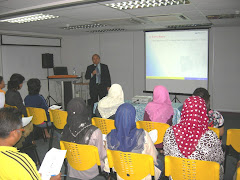
Laporan Terkini: 14 kematian setakat ini dan 16 kes baru dikesan. Sila pakai topeng muka untuk mencegah dari virus H1N1 untuk kebaikan anda dan semua. Elakkan dari tempat awam.
Berita yang dikeluarkan oleh Kementerian Kesihatan Malaysia setakat petang tadi 5 Ogos 2009 menunjukkan angka kematian di seluruh negara akibat wabak selsema H1NI adalah seramai 12 orang. Bilangan kes baru pada hari ini adalah sebanyak 16 kes tempatan.
Sejak laporan penyebaran wabak penyakit ini di negara kita sebanyak 1,476 kes telah dilaporkan. Angka ini dijangka akan meningkat kiranya langkah berjaga-jaga tidak diambil.
Tinjauan yang dibuat di sekitar pusat beli belah di Ipoh menunjukkan bahawa orang ramai tidak mengambil inisiatif untuk mengawal penyakit. Tiada seorang insan yang waras pun kelihatan memakai topeng mulut. Yang bersin dan batuk pula tidak menutup mulut serta tidak menggunakan sapu tangan atau kertas tisu. Ini menampakkan bahawa ramai yang masih memandang ringan mengenai kesan H1N1 ini ataupun mereka tidak tahu akan implikasinya.
Di OUM Perak pula sepanjang peperiksaan kelihatan hanya seorang pelajar sahaja yang memakai topeng mulut. Sebagai langkah berjaga-jaga, semua staf OUM Perak telah disuruh untuk menggunakan topeng mulut semasa berurusan di kaunter mahupun semasa mengawal peperiksaan.
Ingat sebelum kena. Orang yang berisiko tinggi termasuk yang obese (gemuk), yang mengidap penyakit asma serta mempunyai daya ketahanan badan yang rendah. Berikut adalah langkah-langkah berjaga bagi mencegah penyakit H1N1 sila layari laman web Kementerian Kesihatan Malaysia seperti berikut: http://h1n1.moh.gov.my/ atau:


Berita yang dipetik dari Malaysian Insider hari ini menyatakan bahawa wabak H1N1 ini tidak dapat dikawal lagi.
H1N1 can no longer be contained
 A nurse from the California Nurses Association attends a rally to protest what nurses say are safety gaps in California hospitals preparation for an H1N1 pandemic. – Reuters pic
A nurse from the California Nurses Association attends a rally to protest what nurses say are safety gaps in California hospitals preparation for an H1N1 pandemic. – Reuters picWASHINGTON, Aug 6 — Closing schools, stopping large gatherings and other such measures are unlikely to do much to prevent the spread of the H1N1 swine flu pandemic, a team of experts predicted yesterday.
They said pandemic closely resembles the pandemic of H2N2 influenza in 1957 when it quickly became apparent that there was little officials could do to stop it.
“Efforts to mitigate it were futile,” Brooke Courtney Center for Biosecurity at the University of Pittsburgh Medical Centre said in a telephone interview.
Federal officials are expected to announce their recommendations for school closures tomorrow. Local school districts and states usually make the decision to close schools, but they look to the federal government for advice.
At the height of the epidemic in May, more than 700 schools closed in the United States, according to the Department of Education.
In Mexico, where the pandemic started, officials closed government offices and schools for around two weeks in April and May, and encouraged businesses to close.
H1N1 is still circulating and, just as influenza did in 1957, it is dominating the mixture of viruses in the southern hemisphere’s flu season going on now.
In its latest update last week the World Health Organisation reported 162,230 confirmed cases and 1,154 deaths. But flu experts said this probably reflected only a fraction of the true count as not every patient can be diagnosed with a lab test.
Experts expect the flu will pick up activity in the northern hemisphere’s autumn and the WHO predicted one third of the world’s population — two billion people — will eventually be infected.
TOO WIDESPREAD
Governments are taking different approaches to slowing the spread of the virus. Last month, British experts on the spread of disease said closing schools at the first sign of a new pandemic might delay the worst so health officials can prepare, but cannot prevent the spread of the disease.
Writing in the journal Biosecurity and Bioterrorism, Courtney, Dr. DA Henderson and colleagues said it appears that the new H1N1 is now too widespread to try to stop.
“In 1957 it was decided pretty early on that efforts to quarantine or isolate people would not be effective,” Courtney said.
As happened this year, the virus first appeared in the northern hemisphere’s spring. It worsened in the fall. “The opening of schools in September appeared to be a major factor in initiating community epidemics,” the researchers wrote.
“Schools were not closed for the purpose of trying to control the spread of disease. They were closed because too many teachers or administrators or students were out,” Courtney said.
In 1957, 25 per cent of the US population became ill. Global health experts estimate two million people died.
“What we saw was that the federal government took very practical steps to deal with the expected pandemic in the fall in 1957,” Courtney said. “They understood that, yes, it was expected that there would be a lot of people who got sick.”
In 1957 it took months to make a vaccine and then it was not very effective, the researchers found.
Drug companies have started making vaccine against H1N1 swine flu. But the recommended population of 160 million people, including healthcare workers and pregnant women, cannot be fully immunised until December, experts estimate. Two doses are needed for full protection. — Reuters






























No comments:
Post a Comment